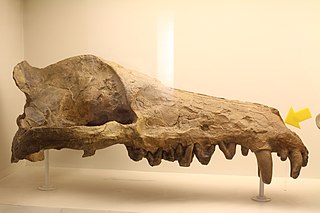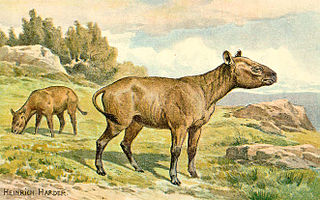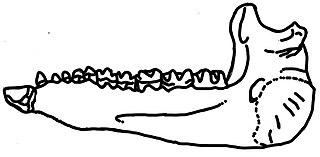
Andrewsarchus is an extinct genus of ungulate that lived during the Middle Eocene in China. It contains two species, A. mongoliensis and A. crassum. It was formerly placed in the families Mesonychidae or Arctocyonidae, but is now the sole member of a distinct family, Andrewsarchidae. Only known from a largely complete skull as well as isolated teeth, it is notable for being estimated as the largest terrestrial, carnivorous mammal, but that status has been disputed.

Sarkastodon is an extinct genus of placental mammals from extinct subfamily Oxyaeninae within extinct family Oxyaenidae, that lived in Asia during the middle Eocene. It was a genus of large, carnivorous animals known only from a skull and jawbones. Sarkastodon was probably a hypercarnivore that preyed on large mammals in its range during the Middle Eocene, such as brontotheres, chalicotheres, and rhinoceroses. Its weight is estimated at 800 kg (1,800 lb), and its length at 3 m (10 ft).

Dipodoidea is a superfamily of rodents, also known as dipodoids, found across the Northern Hemisphere. This superfamily includes over 50 species among the 16 genera in 3 families. They include the jerboas, jumping mice, and birch mice. Different species are found in grassland, deserts, and forests. They are all capable of saltation, a feature that is most highly evolved in the desert-dwelling jerboas.
Eurymylidae is a family of extinct simplicidentates. Most authorities consider them to be basal to all modern rodents and may have been the ancestral stock whence the most recent common ancestor of all modern rodents arose. However, the more completely known eurymylids, including Eurymylus, Heomys, Matutinia, and Rhombomylus, appear to represent a monophyletic side branch not directly ancestral to rodents. Huang et al. (2004) have argued that Hanomys, Matutinia, and Rhombomylus form a clade characterized by distinctive features of the skull and dentition that should be recognized as a separate family, Rhombomylidae. Eurymylids are only known from Asia.
Armintomys is an extinct genus of rodent from North America related to jerboas and jumping mice. It is the only genus in the family Armintomyidae. It lived during the early Eocene, and is the oldest known example of a hystricomorphous zygomasseteric dentition. In addition, Armintomys is also the oldest known rodent that had an incisor enamel transition from pauciserial to uniserial. Its remains have only been found in the Wind River Basin in Wyoming, and could be found there during the species' existence on Earth. It was previously assumed that Armintomys belonged to the Dipodoidea family, but has since been understood to have been part of an early radiation of dipodoid rodents, but was not directly ancestral to any later dipodoids, thus it was recategorized into its own family.

Ailuravus is a genus of prehistoric rodents in the family Ischyromyidae.

The tarbagan marmot is a species of rodent in the family Sciuridae. It is found in China, northern and western Mongolia, and Russia. In the Mongolian Altai Mountains, its range overlaps with that of the Gray marmot. The species was classified as endangered by the IUCN in 2008.

The Hyracodontidae are an extinct family of rhinocerotoids endemic to North America, Europe, and Asia during the Eocene through early Oligocene, living from 48.6 to 26.3 million years ago (Mya), existing about 22.3 million years.
Alagomyidae is a family of rodents known from the late Paleocene and early Eocene of Asia and North America. Alagomyids have been identified as the most basal rodents, lying outside the common ancestry of living forms. Because of their phylogenetic position and their conservative dental morphology, alagomyids have played a key role in investigations of the origins and relationships of rodents.
Ivanantonia is the only genus in the extinct rodent family Ivanantoniidae and is represented by a single species, Ivanantonia efremovi, from the early Eocene of Mongolia. Ivanantonia is poorly known, with only the lower dentition represented. The genus is unusual among early rodents in lacking all lower premolars and in showing evidence of propalinal chewing. The relationships of Ivanantonia are unclear. It was described as a ctenodactyloid. Hartenberger et al. suggested a potential relationship to the muroid Nonomys but declined to assign Ivanantoniidae to a suborder within Rodentia.

Anosteira is an extinct genus of carettochelyid turtle from the Eocene to the Oligocene of Asia and North America.

Asiavorator is an extinct genus of civet-like carnivoran belonging in the family Stenoplesictidae. It was endemic to Asia and lived during the Eocene and Oligocene epochs.
The Irdin Manha Formation is a geological formation from the Eocene located in Inner Mongolia, China, a few kilometres south of the Mongolian border.
Erlianomys combinatus is an extinct species of myodont rodent which existed in Inner Mongolia, China, during the early Eocene period.

Trionyx is a genus of softshell turtles belonging to the family Trionychidae. In the past many species in the family were classified in this genus, but today T. triunguis, the African or Nile softshell turtle, is the only extant softshell still classified as Trionyx. The other species still assigned to this genus are only known from fossils. T. triunguis is a relatively large, aquatic piscivore.

Urtinotherium is an extinct genus of paracerathere mammals. It was a large animal that was closely related to Paraceratherium, and found in rocks dating from the Late Eocene to Early Oligocene period. The remains were first discovered in the Urtyn Obo region in Inner Mongolia, which the name Urtinotherium is based upon. Other referred specimens are from northern China.

Prolimnocyon is an extinct paraphyletic genus of limnocyonid hyaenodonts that lived in Asia and North America during the late Paleocene to middle Eocene. Prolimnocyon chowi is the earliest known member of the hyaenodontid family Limnocyonidae.
Paracolodon is an extinct genus of tapiroid perissodactyl belonging to the family Helaletidae. Fossils have been found in Mongolia and the Inner Mongolia region of China.

Anagalidae is an extinct family of mammals closely related to rodents and lagomorphs. Members of the family are known from Paleocene to Oligocene deposits in China and Mongolia.
Astigalidae is an extinct family of mammals related to the rodents and lagomorphs. Members of the family are known from the Paleocene and Eocene of China.











